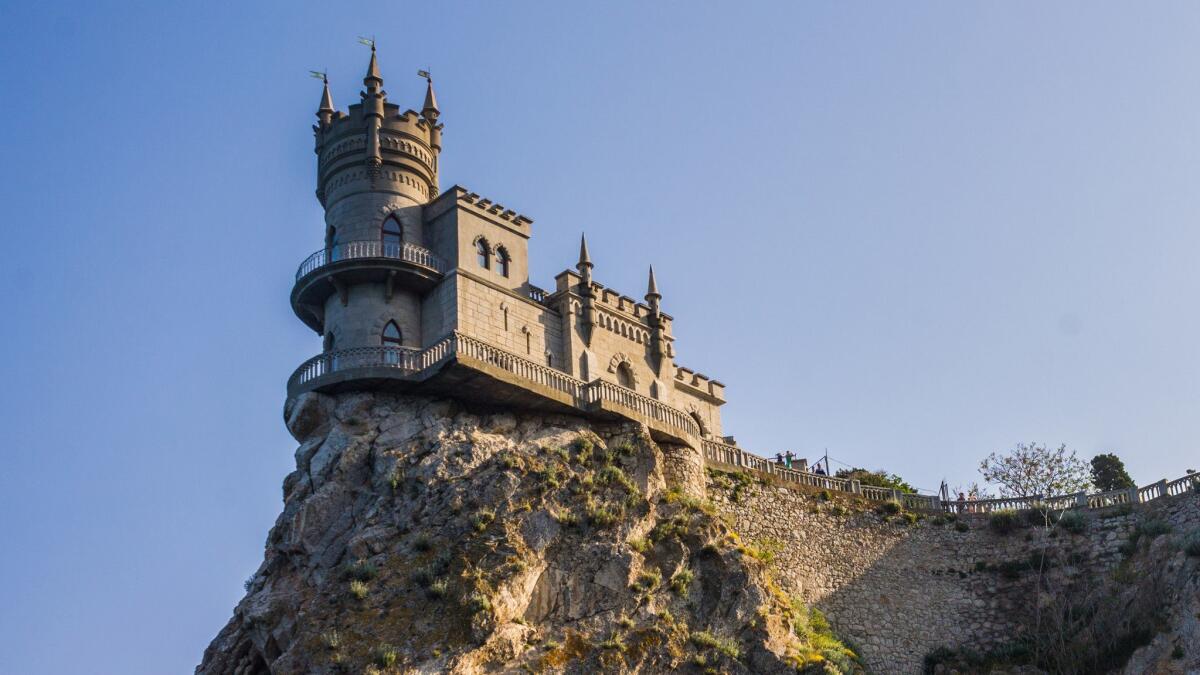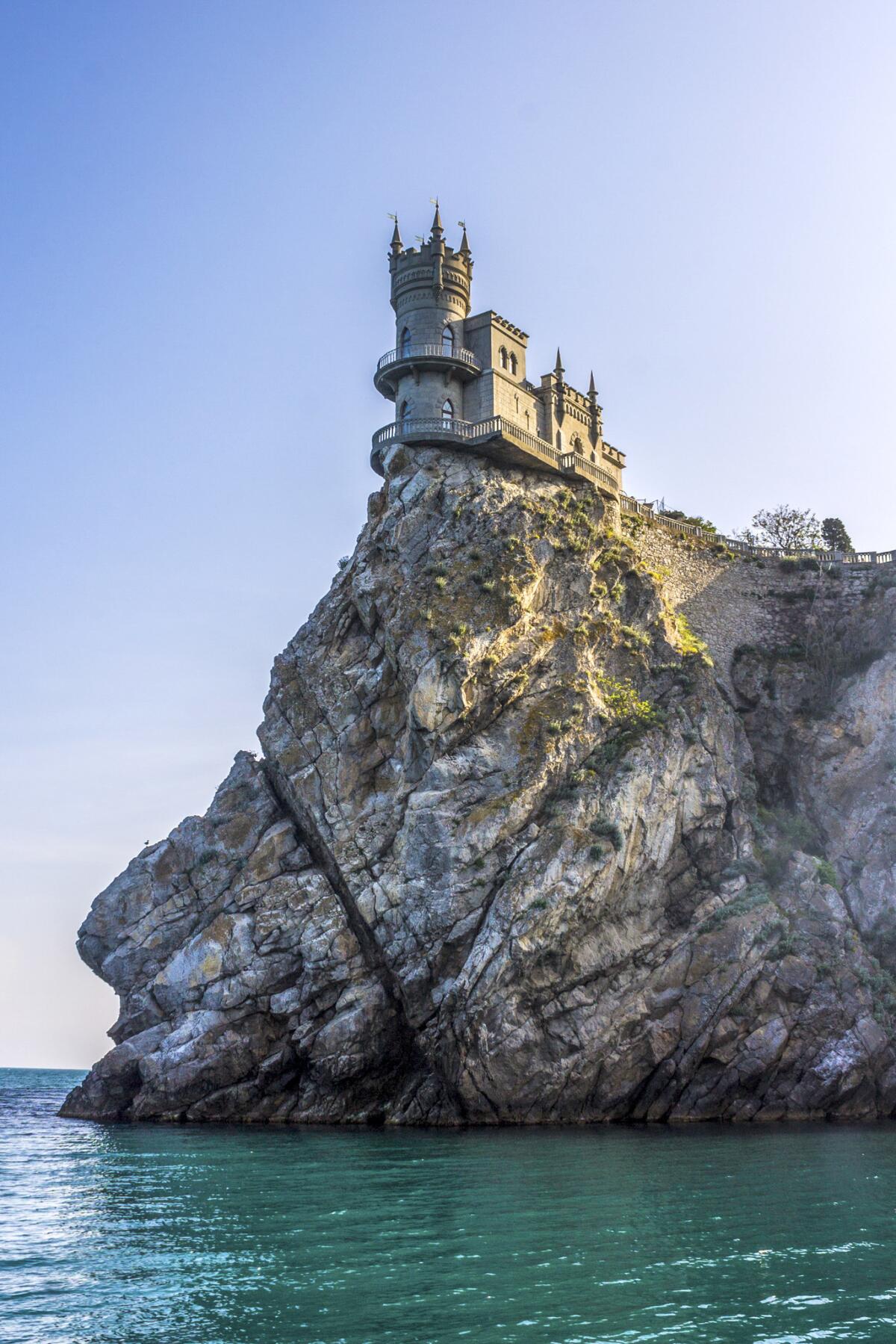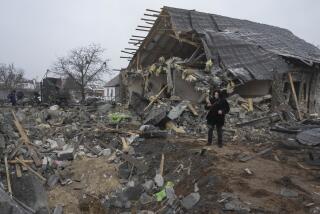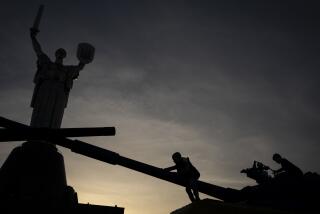Crimea is an unexpected beauty set against an unsettled history

If you think of Crimea at all, it’s probably because of the Yalta Conference, where Stalin, Churchill and Roosevelt met before the final push that brought Germany to its knees. During that February 1945 meeting along the Black Sea coast, Stalin promised his companions that there would be free elections in the Eastern European countries in the postwar world. We know how that turned out.
Crimea’s history is long and tangled. It is today under Russian control, as it has been — sometimes as an autonomous region, sometimes as a part of the Soviet Union — since 1783. Nikita Khrushchev gifted it to Ukraine in the 1950s as a symbolic gesture when Ukraine as a country did not exist but was, instead, just another state in the Union of Soviet Socialist Republics.
For the record:
6:00 p.m. June 24, 2019This article has been updated to reflect that entering Crimea from Russia is a violation of Ukrainian law, and that those who do so risk criminal prosecution in Ukraine, which could include possible denial of entry to Ukraine or imprisonment. In addition, the State Department has recommended against U.S. citizens traveling to Crimea “due to Russia’s occupation of the Ukrainian territory and abuses by its occupying authorities.”
In 2014, Russia wrested Crimea from Ukraine, now an independent country — a move that led to international condemnation and the imposition of sanctions. Further, entering Crimea from Russia is a violation of Ukrainian law, and those who do so risk criminal prosecution in Ukraine, which could include possible denial of entry to Ukraine or imprisonment.
The predominantly Russian population welcomed the return, but the once-exiled Crimean Tatars did not. And if the Crimeans insist that they are better off than they were five years ago — because of new investments in infrastructure that have made it Russia’s fastest growing economic region — Russia’s occupation remains a controversial issue among other world leaders.
Just last week, German Chancellor Angela Merkel insisted that Western sanctions should be kept in place until Russia returns Crimea to Ukraine. And five years on, there are signs that even those who welcomed the annexation may be having second thoughts. The U.S. State Department also urges travelers not to travel to Crimea.
Given this politically charged situation, why recommend Crimea as a travel destination? I’ve been here five times so far this year, and believe it is a picturesque, hospitable country that more Westerners should experience, even if some are initially squeamish about fueling the economy of a disputed territory with their tourist dollars.
In an age when Instagram junkies have overexposed much of the planet, Crimea stands apart for unspoiled authenticity enjoyed by few, save Russians and travelers from the former Soviet bloc. (It’s estimated that of the 6 million people who visited Crimea last year, 85% were Russian.)
Imagine that mountainous California and coastal Ireland had a Russian-speaking love child, then decorated the nursery with ancient ruins, vineyards, monolithic mountains, vast forests, canyons and waterfalls, cliffs rising defiantly above the sea, quaint coastal communities hiding world history, oh, and a secret submarine base where the nuclear destruction of America was once plotted — and it all fits in a region compact enough to see everything in less than a week.
You could fashion numerous itineraries for a Crimean holiday, but setting historic Yalta as a base and venturing out on day trips is a solid strategy for experiencing some of the best this peninsula offers.
Day 1: Yalta and Crimean wines
I’m convinced that Yalta is the Santa Barbara (or maybe La Jolla) of Russia. From certain vantage points, it hints of the Hollywood Hills.
Yalta, a compact city of almost 80,000, squeezes in between the Black Sea and a looming mountain range. Boutiques, clubs, restaurants and hotels line a wide, leafy boardwalk along the shoreline. Of course, a statue of Lenin stands sentinel, and a mural of a seafaring Vladimir Putin reminds you which country now owns the peninsula.
Here, families and tourists stroll, relax, dine, shop, listen to crooning buskers and bands or pop down to the gravelly beach for a dip in Black Sea waters warmed by the summer sun.
Pedestrian-only Pushkin Street presents its collection of coffee shops, boutiques and restaurants. Street artists hawk paintings that are generic at worst, good at best.

A 15-minute bus ride will take you to Massandra, the peninsula’s leading winery. Crimea, with a latitude close to that of the grape-growing regions of Oregon and upstate New York, produces copious wine. Indeed, any drive outside of Yalta passes numerous vineyards.
So few Westerners visit Crimea, however, that most tours are in Russian. Massandra offers an English-language tour for $150 for as many as 10 people, including kids. On my tour, I counted at least half a dozen teens.
Or, as I did, take the Russian tour for about $10 (tasting included) just to see the place and taste the wines.
But prepare your palate. Russians tend to prefer wine on the sugary side, so expect a lot of dessert and semi-sweet wines. That said, the Madeira and the South Coast white Muscat were particularly nice.
Day 2: The Palaces
Once you see coastal Crimea, you’ll understand why czars, princes and Soviet leaders favored this area for their holiday homes. Some left monuments to their wealth and stature in the form of 19th century palaces with vast gardens stretching to the sea.
First stop: Morning at Vorontsov Palace, built in the first half of the 1800s by a Russian prince who spent his childhood in London, which explains its Tudor look mixed with Ottoman and Moorish flair.
It also explains why Vorontsov was Churchill’s base during the Yalta Conference.
As I stood in the courtyard to buy tickets, I looked at the wall of mountains to the north and thought, “Must be what the White Walkers confronted in ‘Game of Thrones.’” These mountains are that sheer and towering.
Despite Crimea’s numerous geopolitical upheavals, Vorontsov and its 150-room interior remain largely as they were in the 19th century — a time capsule of architectural and design styles of the period.
The palace sits amid 75 acres of parkland designed by a German botanist and filled with 200 plant species from around the world. Garden paths lead throughout the property and down to the sea.
When you’re returning to Yalta, stop for the afternoon at Livadia Palace, the site of the Yalta Conference and Roosevelt’s residence during that period.

This seaside Italianate palace was the summer residence of the last of the Romanov clan, Russia’s most famous imperial family. Indeed, Czar Nicholas II wanted to retire here with his family after the Bolshevik revolution. Alas, Nicholas and family were killed instead.
Only parts of the authentic Romanov interior remain. In fact, the palace was a mental institution during Soviet times. Still, the interior reflects the Romanov era and fits the Eclecticism movement of the late 19th century. Byzantine, Modern, Gothic and Arabic influences all make an appearance.
The first floor pays homage to the Yalta Conference. Wax figures of Roosevelt, Churchill and Stalin sit at the table used during their meetings. A peaceful, leafy interior courtyard provides the backdrop to one of the conference’s most famous photos: all three leaders sitting together.
Surrounding the palace are 150 acres of heavily landscaped and hilly parkland, with footpaths leading to the sea. In summer, you can take the outdoor elevator directly to the beach.
Day 3 : Panoramic views and a fairy tale castle

A 15-minute cable-car journey from near Vorontsov Palace ferries you to the top of Ai-Petri (St. Peter), at nearly 4,050 feet one of the peninsula’s tallest peaks.
Here, you’ll find walking trails offering spectacular views as well as a nice Tatar restaurant and souvenir shops. A 15-minute hike up a forested mountain leads you to the peak with panoramic views of the coast below. Or test your mettle crossing a wood-plank bridge to a lone rocky spire that rises like a steroidal stalagmite. Be warned: Winds here sometimes top 100 mph.
Take a cab down the mountain instead of the cable car. You’ll wind beneath a pine-and-beech forest canopy that, on a sunny day, radiates a vibrant chartreuse.
On your way back to Yalta, stop at the Swallow’s Nest, easily the most photographed spot in Crimea. A German nobleman in 1912 built a fairy-tale castle on a narrow promontory over the sea.
Day 4: A secret subterranean submarine base and an ancient fortress
In Soviet times, the quaint coastal hamlet ofBalaklava was so secret that leaders referred to it as Object 825. Not even the families of naval seaman based here knew of its existence. The reason: A secret lay beneath the mountain — a Soviet nuclear submarine base designed to survive a direct nuclear attack.
Today, for about $3, you can tour this interesting Cold War relic. The tour is in Russian, so you won’t learn much, but just being in an old Soviet nuclear-sub base beneath a mountain is cool.
Across the bay from the submarine base are the stone remains of a 14th century Genoese fortress, built on the side of a mountain overlooking Balaklava’s harbor, which makes an appearance in Homer’s “Odyssey.”
The hike to the top (free) takes 15 to 20 minutes and rewards you with a view of lush coastal cliffs pressing against the Black Sea below.
If you go
THE BEST WAY TO CRIMEA
From LAX, Aeroflot, Delta, Air New Zealand, LOT, Jet Blue, KLM, Scandinavian, Virgin Atlantic and British offer connecting service (change of planes) to Simferopol, the only commercial airport in Crimea. Restricted round-trip airfare from $1,510, including taxes and fees.
From Simferopol, hire a private car or taxi to take you to Yalta, about 90 minutes away, for $25 to $30.
Visa: You’ll need a visa for Russia. See information from the Russian Embassy to learn more. The U.S. State Department warns that it is unable to provide emergency services to U.S. citizens traveling in Crimea.
Western debit and credit cards don’t work in Crimea. Book your hotel online and pay for it before you travel. When you get to Moscow, use your debit card to pull enough rubles from an ATM to cover your food and touring expenses. And bring a couple of hundred U.S. dollars as a fail safe, just in case you need it.
Western mobile carriers have ring-fenced Crimea, so your phone will work only with WiFi. You won’t get service for texting or making phone calls.
WHERE TO STAY
Hotel Oreanda, 35/2Lenin Quay, 35/2, Yalta, Crimea. A low-rise, Art Nouveau property from 1907 designed to resemble a palace. It sits on the boardwalk, with seaside rooms overlooking the Black Sea. Doubles from $155.
Yalta Intourist,50 Drazhinsky St., Yalta, Crimea. Large, modern family-focused hotel about 2½ miles from the boardwalk. If you’re traveling with kids, it has its own water park. Standard superior rooms from $175.
Villa Elena, 3A Morskaya St., Yalta, Crimea. Italianate palace from 1912, about 35 yards from the sea and long-considered the best hotel in Yalta. Beautiful rooms with handmade Italian furnishings and a park-like hotel setting. Deluxe rooms from about $270.
WHERE TO EAT
Apelsin Fusion Café, 8 Lenin Quay, Yalta, Crimea. You can’t miss it — it looks like a Viking ship on stilts jutting into the bay. Will meet everyone’s needs, from steak to sushi to pizza (and top-notch cucumber-mint lemonade).
Karamba Bar and Restaurant; 10 Frunze, Alupka, Crimea. Pirate-themed restaurant near Vorontsov Palace. and left “Los Angeles” scrawled into the leather folder. Good for lunch. Fresh salads, pizzas, shish kebabs (called shashlik) of pork, beef, chicken or lamb, and seafood.
Caucasian Restaurant, 22 A Baturina St., Livadia, Crimea. Quite good Georgian eatery near Livadia Palace. Fresh seafood from the Black Sea.Definitely try the khachapuri — a flat, football-shaped bread with a salty cheese in the middle and anegg on top. Extensive wine list (Georgian wines are generally quite good).
Necessary information:
To reach Massandra Winery, take a taxi for a few dollars, or, as I did for 30 cents: the No. 9 bus from a park on Karl Marx Street The basic winery tour costs about $4.60. T
Your hotel can help you arrange a driver for your excursions from Yalta. Expect to pay about 5,000 rubles ($75) for the day. Or it can help you arrange transport on a tour bus to the palaces.
Finally, download the Russian language into the Google Translate app on your smartphone. Then, when you’re at restaurants and elsewhere, you can use the “camera” function in the app to translate, live, whatever you’re trying to read, even when you’re offline. The translation is ludicrous at times, but mostly it gets the job done.
More to Read
Sign up for The Wild
We’ll help you find the best places to hike, bike and run, as well as the perfect silent spots for meditation and yoga.
You may occasionally receive promotional content from the Los Angeles Times.






